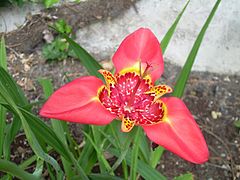| Tigridia pavonia | |
|---|---|

| |
| A yellow-flowered form | |
| Scientific classification | |
| Kingdom: | Plantae |
| Clade: | Tracheophytes |
| Clade: | Angiosperms |
| Clade: | Monocots |
| Order: | Asparagales |
| Family: | Iridaceae |
| Genus: | Tigridia |
| Species: | T. pavonia
|
| Binomial name | |
| Tigridia pavonia | |
| Synonyms[2] | |
|
List
| |
Tigridia pavonia is a species of flowering plant in the iris family Iridaceae. Common names include jockey's cap lily,[3] Mexican shellflower,[4] peacock flower,[4] tiger iris,[5] and tiger flower.[4] This summer-flowering bulbous herbaceous perennial is widespread across much of Mexico, Guatemala, El Salvador, and Honduras. It is naturalized in Ecuador and Peru.[4][6]
The leaves are narrow and lance-shaped. The three-petalled blooms occur in a variety of colours with strongly contrasting central markings.[7] They open early in the morning and close before dusk. Blooms are successional throughout summer. Plants bloom in the first year after sowing.[citation needed]
Tigridia pavonia is cultivated as an ornamental plant. It prefers a sheltered position in full sun, in sandy but fertile soil. The plants are said to be hardy to as low as −12 °C (10 °F) in many sources,[8][9][10] while in some others only to 5 °C (41 °F).[7] Most authorities recommend that the corms should be lifted and stored throughout the winter months in colder areas.[7][10]
The roasted bulbs are edible and have been used by the American Indians and Indigenous peoples of Mexico. It has a chestnut-like flavour.[5]
The aphid Aphis newtoni may be found on this plant.[11]
- ^ "Tigridia pavonia". International Plant Names Index (IPNI). Royal Botanic Gardens, Kew; Harvard University Herbaria & Libraries; Australian National Botanic Gardens. Retrieved 2 August 2021.
- ^ "Tigridia pavonia". World Checklist of Selected Plant Families. Royal Botanic Gardens, Kew – via The Plant List. Note that this website has been superseded by World Flora Online
- ^ Books, M.; Limited, M.B.P. (2004). Growing Bulbs. Murdoch Books. ISBN 9781740455206.
- ^ a b c d "Tigridia pavonia". Germplasm Resources Information Network. Agricultural Research Service, United States Department of Agriculture. Retrieved 16 January 2014.
- ^ a b Alan Davidson The Oxford Companion to Food, p. 116, at Google Books
- ^ Kew World Checklist of Selected Plant Families
- ^ a b c "Tigridia pavonia". RHS. Retrieved 28 July 2021.
- ^ Taylor's Encyclopedia of Garden Plants. Frances Tenenbaum, ed. Houghton Mifflin, 2003. p. 387. ISBN 9780618226443
- ^ "Tigridia pavonia". Plants for a Future. Retrieved 25 March 2024.
- ^ a b "Tigridia pavonia" at North Carolina Extension Gardener Plant Toolbox. Retrieved 25 March 2024.
- ^ Proceedings of the Estonian Academy of Sciences, Biology and Ecology June 2002 Proceedings of the Estonian Academy of Sciences, Biology and Ecology June 2002, p. 128, at Google Books



